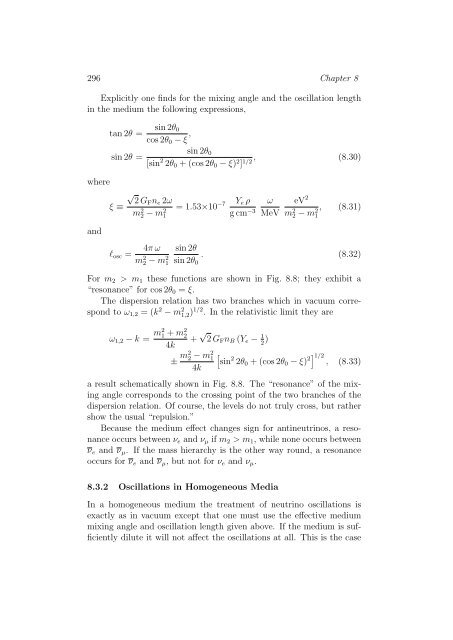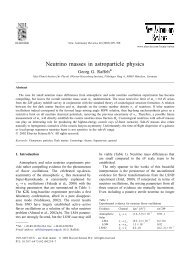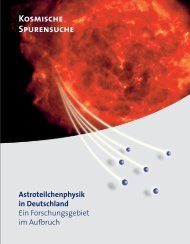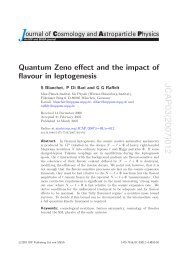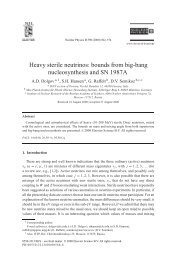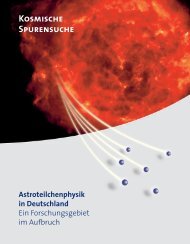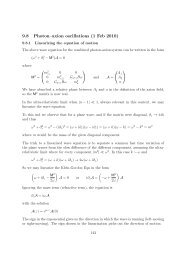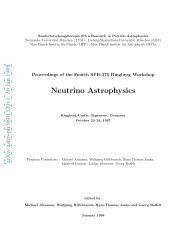- Page 1 and 2:
Georg G. Raffelt Stars as Laborator
- Page 3 and 4:
Table of Contents Preface (xiv) Ack
- Page 5 and 6:
Table of Contents vii 4.5 Neutrino
- Page 7 and 8:
Table of Contents ix 8. Neutrino Os
- Page 9 and 10:
Table of Contents xi 12. Radiative
- Page 11 and 12:
Table of Contents xiii 16.3 New Int
- Page 13 and 14:
Preface xv Second, particles from d
- Page 15 and 16:
Preface xvii search for proton deca
- Page 17 and 18:
Preface xix cuts of higher-order gr
- Page 19 and 20:
Preface xxi quoted “astrophysical
- Page 21 and 22:
Chapter 1 The Energy-Loss Argument
- Page 23 and 24:
The Energy-Loss Argument 3 example
- Page 25 and 26:
The Energy-Loss Argument 5 trinos,
- Page 27 and 28:
The Energy-Loss Argument 7 As a sim
- Page 29 and 30:
The Energy-Loss Argument 9 The most
- Page 31 and 32:
The Energy-Loss Argument 11 against
- Page 33 and 34:
The Energy-Loss Argument 13 ing M;
- Page 35 and 36:
The Energy-Loss Argument 15 M ′ (
- Page 37 and 38:
The Energy-Loss Argument 17 Table 1
- Page 39 and 40:
The Energy-Loss Argument 19 ing to
- Page 41 and 42:
The Energy-Loss Argument 21 scalars
- Page 43 and 44:
Chapter 2 Anomalous Stellar Energy
- Page 45 and 46:
Anomalous Stellar Energy Losses Bou
- Page 47 and 48:
Anomalous Stellar Energy Losses Bou
- Page 49 and 50:
Anomalous Stellar Energy Losses Bou
- Page 51 and 52:
Anomalous Stellar Energy Losses Bou
- Page 53 and 54:
Anomalous Stellar Energy Losses Bou
- Page 55 and 56:
Anomalous Stellar Energy Losses Bou
- Page 57 and 58:
Anomalous Stellar Energy Losses Bou
- Page 59 and 60:
Anomalous Stellar Energy Losses Bou
- Page 61 and 62:
Anomalous Stellar Energy Losses Bou
- Page 63 and 64:
Anomalous Stellar Energy Losses Bou
- Page 65 and 66:
Anomalous Stellar Energy Losses Bou
- Page 67 and 68:
Anomalous Stellar Energy Losses Bou
- Page 69 and 70:
Anomalous Stellar Energy Losses Bou
- Page 71 and 72:
Anomalous Stellar Energy Losses Bou
- Page 73 and 74:
Anomalous Stellar Energy Losses Bou
- Page 75 and 76:
Anomalous Stellar Energy Losses Bou
- Page 77 and 78:
Anomalous Stellar Energy Losses Bou
- Page 79 and 80:
Anomalous Stellar Energy Losses Bou
- Page 81 and 82:
Anomalous Stellar Energy Losses Bou
- Page 83 and 84:
Anomalous Stellar Energy Losses Bou
- Page 85 and 86:
Anomalous Stellar Energy Losses Bou
- Page 87 and 88:
Anomalous Stellar Energy Losses Bou
- Page 89 and 90:
Anomalous Stellar Energy Losses Bou
- Page 91 and 92:
Anomalous Stellar Energy Losses Bou
- Page 93 and 94:
Anomalous Stellar Energy Losses Bou
- Page 95 and 96:
Anomalous Stellar Energy Losses Bou
- Page 97 and 98:
Anomalous Stellar Energy Losses Bou
- Page 99 and 100:
Anomalous Stellar Energy Losses Bou
- Page 101 and 102:
Anomalous Stellar Energy Losses Bou
- Page 103 and 104:
Anomalous Stellar Energy Losses Bou
- Page 105 and 106:
Anomalous Stellar Energy Losses Bou
- Page 107 and 108:
Anomalous Stellar Energy Losses Bou
- Page 109 and 110:
Chapter 3 Particles Interacting wit
- Page 111 and 112:
Particles Interacting with Electron
- Page 113 and 114:
Particles Interacting with Electron
- Page 115 and 116:
Particles Interacting with Electron
- Page 117 and 118:
Particles Interacting with Electron
- Page 119 and 120:
Particles Interacting with Electron
- Page 121 and 122:
Particles Interacting with Electron
- Page 123 and 124:
Particles Interacting with Electron
- Page 125 and 126:
Particles Interacting with Electron
- Page 127 and 128:
Particles Interacting with Electron
- Page 129 and 130:
Particles Interacting with Electron
- Page 131 and 132:
Particles Interacting with Electron
- Page 133 and 134:
Particles Interacting with Electron
- Page 135 and 136:
Particles Interacting with Electron
- Page 137 and 138:
Chapter 4 Processes in a Nuclear Me
- Page 139 and 140:
Processes in a Nuclear Medium 119 t
- Page 141 and 142:
Processes in a Nuclear Medium 121 f
- Page 143 and 144:
Processes in a Nuclear Medium 123 F
- Page 145 and 146:
Processes in a Nuclear Medium 125 F
- Page 147 and 148:
Processes in a Nuclear Medium 127 F
- Page 149 and 150:
Processes in a Nuclear Medium 129 v
- Page 151 and 152:
Processes in a Nuclear Medium 131 4
- Page 153 and 154:
Processes in a Nuclear Medium 133 i
- Page 155 and 156:
Processes in a Nuclear Medium 135 H
- Page 157 and 158:
Processes in a Nuclear Medium 137 I
- Page 159 and 160:
Processes in a Nuclear Medium 139 F
- Page 161 and 162:
Processes in a Nuclear Medium 141 F
- Page 163 and 164:
Processes in a Nuclear Medium 143 i
- Page 165 and 166:
Processes in a Nuclear Medium 145 s
- Page 167 and 168:
Processes in a Nuclear Medium 147 E
- Page 169 and 170:
Processes in a Nuclear Medium 149 a
- Page 171 and 172:
Processes in a Nuclear Medium 151 T
- Page 173 and 174:
Processes in a Nuclear Medium 153 r
- Page 175 and 176:
Processes in a Nuclear Medium 155 4
- Page 177 and 178:
Processes in a Nuclear Medium 157 I
- Page 179 and 180:
Processes in a Nuclear Medium 159 t
- Page 181 and 182:
Processes in a Nuclear Medium 161 A
- Page 183 and 184:
Processes in a Nuclear Medium 163 R
- Page 185 and 186:
Chapter 5 Two-Photon Coupling of Lo
- Page 187 and 188:
Two-Photon Coupling of Low-Mass Bos
- Page 189 and 190:
Two-Photon Coupling of Low-Mass Bos
- Page 191 and 192:
Two-Photon Coupling of Low-Mass Bos
- Page 193 and 194:
Two-Photon Coupling of Low-Mass Bos
- Page 195 and 196:
Two-Photon Coupling of Low-Mass Bos
- Page 197 and 198:
Two-Photon Coupling of Low-Mass Bos
- Page 199 and 200:
Two-Photon Coupling of Low-Mass Bos
- Page 201 and 202:
Two-Photon Coupling of Low-Mass Bos
- Page 203 and 204:
Two-Photon Coupling of Low-Mass Bos
- Page 205 and 206:
Two-Photon Coupling of Low-Mass Bos
- Page 207 and 208:
Two-Photon Coupling of Low-Mass Bos
- Page 209 and 210:
Two-Photon Coupling of Low-Mass Bos
- Page 211 and 212:
Two-Photon Coupling of Low-Mass Bos
- Page 213 and 214:
Chapter 6 Particle Dispersion and D
- Page 215 and 216:
Particle Dispersion and Decays in M
- Page 217 and 218:
Particle Dispersion and Decays in M
- Page 219 and 220:
Particle Dispersion and Decays in M
- Page 221 and 222:
Particle Dispersion and Decays in M
- Page 223 and 224:
Particle Dispersion and Decays in M
- Page 225 and 226:
Particle Dispersion and Decays in M
- Page 227 and 228:
Particle Dispersion and Decays in M
- Page 229 and 230:
Particle Dispersion and Decays in M
- Page 231 and 232:
Particle Dispersion and Decays in M
- Page 233 and 234:
Particle Dispersion and Decays in M
- Page 235 and 236:
Particle Dispersion and Decays in M
- Page 237 and 238:
Particle Dispersion and Decays in M
- Page 239 and 240:
Particle Dispersion and Decays in M
- Page 241 and 242:
Particle Dispersion and Decays in M
- Page 243 and 244:
Particle Dispersion and Decays in M
- Page 245 and 246:
Particle Dispersion and Decays in M
- Page 247 and 248:
Particle Dispersion and Decays in M
- Page 249 and 250:
Particle Dispersion and Decays in M
- Page 251 and 252:
Particle Dispersion and Decays in M
- Page 253 and 254:
Particle Dispersion and Decays in M
- Page 255 and 256:
Particle Dispersion and Decays in M
- Page 257 and 258:
Particle Dispersion and Decays in M
- Page 259 and 260:
Particle Dispersion and Decays in M
- Page 261 and 262:
Particle Dispersion and Decays in M
- Page 263 and 264:
Particle Dispersion and Decays in M
- Page 265 and 266: Particle Dispersion and Decays in M
- Page 267 and 268: Particle Dispersion and Decays in M
- Page 269 and 270: Particle Dispersion and Decays in M
- Page 271 and 272: Chapter 7 Nonstandard Neutrinos The
- Page 273 and 274: Nonstandard Neutrinos 253 (“spont
- Page 275 and 276: Nonstandard Neutrinos 255 kinematic
- Page 277 and 278: Nonstandard Neutrinos 257 95% CL ma
- Page 279 and 280: Nonstandard Neutrinos 259 Fig. 7.2.
- Page 281 and 282: Nonstandard Neutrinos 261 In three-
- Page 283 and 284: Nonstandard Neutrinos 263 Flavor mi
- Page 285 and 286: Nonstandard Neutrinos 265 Fig. 7.7.
- Page 287 and 288: Nonstandard Neutrinos 267 The quant
- Page 289 and 290: Nonstandard Neutrinos 269 dipole mo
- Page 291 and 292: Nonstandard Neutrinos 271 component
- Page 293 and 294: Nonstandard Neutrinos 273 Fig. 7.8.
- Page 295 and 296: Nonstandard Neutrinos 275 moments.
- Page 297 and 298: Nonstandard Neutrinos 277 7.5.2 Spi
- Page 299 and 300: Nonstandard Neutrinos 279 where m
- Page 301 and 302: Neutrino Oscillations 281 and hence
- Page 303 and 304: Neutrino Oscillations 283 As usual
- Page 305 and 306: Neutrino Oscillations 285 two-flavo
- Page 307 and 308: Neutrino Oscillations 287 Fig. 8.2.
- Page 309 and 310: Neutrino Oscillations 289 8.2.4 Exp
- Page 311 and 312: Neutrino Oscillations 291 Fig. 8.6.
- Page 313 and 314: Neutrino Oscillations 293 Apparentl
- Page 315: Neutrino Oscillations 295 Fig. 8.8.
- Page 319 and 320: Neutrino Oscillations 299 If the ne
- Page 321 and 322: Neutrino Oscillations 301 8.3.5 The
- Page 323 and 324: Neutrino Oscillations 303 It is als
- Page 325 and 326: Neutrino Oscillations 305 system, h
- Page 327 and 328: Neutrino Oscillations 307 say, betw
- Page 329 and 330: Neutrino Oscillations 309 1991). Th
- Page 331 and 332: Oscillations of Trapped Neutrinos 3
- Page 333 and 334: Oscillations of Trapped Neutrinos 3
- Page 335 and 336: Oscillations of Trapped Neutrinos 3
- Page 337 and 338: Oscillations of Trapped Neutrinos 3
- Page 339 and 340: Oscillations of Trapped Neutrinos 3
- Page 341 and 342: Oscillations of Trapped Neutrinos 3
- Page 343 and 344: Oscillations of Trapped Neutrinos 3
- Page 345 and 346: Oscillations of Trapped Neutrinos 3
- Page 347 and 348: Oscillations of Trapped Neutrinos 3
- Page 349 and 350: Oscillations of Trapped Neutrinos 3
- Page 351 and 352: Oscillations of Trapped Neutrinos 3
- Page 353 and 354: Oscillations of Trapped Neutrinos 3
- Page 355 and 356: Oscillations of Trapped Neutrinos 3
- Page 357 and 358: Oscillations of Trapped Neutrinos 3
- Page 359 and 360: Oscillations of Trapped Neutrinos 3
- Page 361 and 362: Chapter 10 Solar Neutrinos The curr
- Page 363 and 364: Solar Neutrinos 343 Fig. 10.1. Sola
- Page 365 and 366: Solar Neutrinos 345 There exist vas
- Page 367 and 368:
Solar Neutrinos 347 10.2 Calculated
- Page 369 and 370:
Solar Neutrinos 349 Fig. 10.3. Norm
- Page 371 and 372:
Solar Neutrinos 351 a certain range
- Page 373 and 374:
Solar Neutrinos 353 While helium an
- Page 375 and 376:
Solar Neutrinos 355 Bahcall and Pin
- Page 377 and 378:
Solar Neutrinos 357 Xu et al. (1994
- Page 379 and 380:
Solar Neutrinos 359 Table 10.4. Spe
- Page 381 and 382:
Solar Neutrinos 361 Table 10.5. Pre
- Page 383 and 384:
Solar Neutrinos 363 rates attribute
- Page 385 and 386:
Solar Neutrinos 365 10.3.4 Water Ch
- Page 387 and 388:
Solar Neutrinos 367 Fig. 10.10. Dif
- Page 389 and 390:
Solar Neutrinos 369 Fig. 10.13. Mea
- Page 391 and 392:
Solar Neutrinos 371 Table 10.9. Cur
- Page 393 and 394:
Solar Neutrinos 373 of order the an
- Page 395 and 396:
Solar Neutrinos 375 Fig. 10.16. 37
- Page 397 and 398:
Solar Neutrinos 377 GALLEX, or Home
- Page 399 and 400:
Solar Neutrinos 379 Table 10.10. Me
- Page 401 and 402:
Solar Neutrinos 381 deficits in all
- Page 403 and 404:
Solar Neutrinos 383 The ν e surviv
- Page 405 and 406:
Solar Neutrinos 385 The allowed ran
- Page 407 and 408:
Solar Neutrinos 387 10.7 Spin and S
- Page 409 and 410:
Solar Neutrinos 389 10.8 Neutrino D
- Page 411 and 412:
Solar Neutrinos 391 The small- and
- Page 413 and 414:
Solar Neutrinos 393 flux above its
- Page 415 and 416:
Chapter 11 Supernova Neutrinos The
- Page 417 and 418:
Supernova Neutrinos 397 Fig. 11.1.
- Page 419 and 420:
Supernova Neutrinos 399 beyond the
- Page 421 and 422:
Supernova Neutrinos 401 ate neutrin
- Page 423 and 424:
Supernova Neutrinos 403 Convection
- Page 425 and 426:
Supernova Neutrinos 405 Hayes, and
- Page 427 and 428:
Supernova Neutrinos 407 11.2 Predic
- Page 429 and 430:
Supernova Neutrinos 409 must then b
- Page 431 and 432:
Supernova Neutrinos 411 Figure 11.6
- Page 433 and 434:
Supernova Neutrinos 413 signal (Sec
- Page 435 and 436:
Supernova Neutrinos 415 time) on 23
- Page 437 and 438:
Supernova Neutrinos 417 All of the
- Page 439 and 440:
Supernova Neutrinos 419 to multiple
- Page 441 and 442:
Supernova Neutrinos 421 the final-s
- Page 443 and 444:
Supernova Neutrinos 423 ter of 53 e
- Page 445 and 446:
Supernova Neutrinos 425 Given these
- Page 447 and 448:
Supernova Neutrinos 427 thorough st
- Page 449 and 450:
Supernova Neutrinos 429 The forward
- Page 451 and 452:
Supernova Neutrinos 431 Another int
- Page 453 and 454:
Supernova Neutrinos 433 ber of ν e
- Page 455 and 456:
Supernova Neutrinos 435 A “normal
- Page 457 and 458:
Supernova Neutrinos 437 Fig. 11.19.
- Page 459 and 460:
Supernova Neutrinos 439 The approxi
- Page 461 and 462:
Supernova Neutrinos 441 be taken to
- Page 463 and 464:
Supernova Neutrinos 443 sense that
- Page 465 and 466:
Supernova Neutrinos 445 presence of
- Page 467 and 468:
Supernova Neutrinos 447 An even mor
- Page 469 and 470:
Chapter 12 Radiative Particle Decay
- Page 471 and 472:
Radiative Particle Decays 451 one c
- Page 473 and 474:
Radiative Particle Decays 453 corre
- Page 475 and 476:
Radiative Particle Decays 455 is no
- Page 477 and 478:
Radiative Particle Decays 457 Fig.
- Page 479 and 480:
Radiative Particle Decays 459 Fig.
- Page 481 and 482:
Radiative Particle Decays 461 12.3.
- Page 483 and 484:
Radiative Particle Decays 463 emiss
- Page 485 and 486:
Radiative Particle Decays 465 range
- Page 487 and 488:
Radiative Particle Decays 467 12.4.
- Page 489 and 490:
Radiative Particle Decays 469 weak
- Page 491 and 492:
Radiative Particle Decays 471 value
- Page 493 and 494:
Radiative Particle Decays 473 ignor
- Page 495 and 496:
Radiative Particle Decays 475 Fig.
- Page 497 and 498:
Radiative Particle Decays 477 Fig.
- Page 499 and 500:
Radiative Particle Decays 479 Table
- Page 501 and 502:
Radiative Particle Decays 481 In or
- Page 503 and 504:
Radiative Particle Decays 483 12.4.
- Page 505 and 506:
Radiative Particle Decays 485 while
- Page 507 and 508:
Radiative Particle Decays 487 h 100
- Page 509 and 510:
Radiative Particle Decays 489 Fig.
- Page 511 and 512:
Radiative Particle Decays 491 still
- Page 513 and 514:
Chapter 13 What Have We Learned fro
- Page 515 and 516:
What Have We Learned from SN 1987A
- Page 517 and 518:
What Have We Learned from SN 1987A
- Page 519 and 520:
What Have We Learned from SN 1987A
- Page 521 and 522:
What Have We Learned from SN 1987A
- Page 523 and 524:
What Have We Learned from SN 1987A
- Page 525 and 526:
What Have We Learned from SN 1987A
- Page 527 and 528:
What Have We Learned from SN 1987A
- Page 529 and 530:
What Have We Learned from SN 1987A
- Page 531 and 532:
What Have We Learned from SN 1987A
- Page 533 and 534:
What Have We Learned from SN 1987A
- Page 535 and 536:
What Have We Learned from SN 1987A
- Page 537 and 538:
What Have We Learned from SN 1987A
- Page 539 and 540:
What Have We Learned from SN 1987A
- Page 541 and 542:
What Have We Learned from SN 1987A
- Page 543 and 544:
What Have We Learned from SN 1987A
- Page 545 and 546:
Axions 525 Table 14.1. Particle mag
- Page 547 and 548:
Axions 527 or axion decay constant.
- Page 549 and 550:
Axions 529 The Yukawa coupling h is
- Page 551 and 552:
Axions 531 14.2.3 Pseudoscalar vs.
- Page 553 and 554:
Axions 533 Notably, the Higgs field
- Page 555 and 556:
Axions 535 otic heavy quarks: only
- Page 557 and 558:
Axions 537 Various axion models dif
- Page 559 and 560:
Axions 539 Bounds on the Yukawa cou
- Page 561 and 562:
Axions 541 Fig. 14.5. Astrophysical
- Page 563 and 564:
Axions 543 decay into axions. This
- Page 565 and 566:
Chapter 15 Miscellaneous Exotica St
- Page 567 and 568:
Miscellaneous Exotica 547 Table 15.
- Page 569 and 570:
Miscellaneous Exotica 549 15.2.3 Pr
- Page 571 and 572:
Miscellaneous Exotica 551 Most rece
- Page 573 and 574:
Miscellaneous Exotica 553 Fig. 15.1
- Page 575 and 576:
Miscellaneous Exotica 555 A violati
- Page 577 and 578:
Miscellaneous Exotica 557 nuclei it
- Page 579 and 580:
Miscellaneous Exotica 559 mass, and
- Page 581 and 582:
Miscellaneous Exotica 561 backgroun
- Page 583 and 584:
Miscellaneous Exotica 563 SN 1987A
- Page 585 and 586:
Miscellaneous Exotica 565 which led
- Page 587 and 588:
Miscellaneous Exotica 567 For a nar
- Page 589 and 590:
Neutrinos: The Bottom Line 569 the
- Page 591 and 592:
Neutrinos: The Bottom Line 571 Neut
- Page 593 and 594:
Neutrinos: The Bottom Line 573 Apar
- Page 595 and 596:
Neutrinos: The Bottom Line 575 is d
- Page 597 and 598:
Neutrinos: The Bottom Line 577 of t
- Page 599 and 600:
Neutrinos: The Bottom Line 579 siti
- Page 601 and 602:
Units and Dimensions 581 In the ast
- Page 603 and 604:
Appendix B Neutrino Coupling Consta
- Page 605 and 606:
Appendix C Numerical Neutrino Energ
- Page 607 and 608:
Numerical Neutrino Energy-Loss Rate
- Page 609 and 610:
Numerical Neutrino Energy-Loss Rate
- Page 611 and 612:
Appendix D Characteristics of Stell
- Page 613 and 614:
Characteristics of Stellar Plasmas
- Page 615 and 616:
Characteristics of Stellar Plasmas
- Page 617 and 618:
Characteristics of Stellar Plasmas
- Page 619 and 620:
Characteristics of Stellar Plasmas
- Page 621 and 622:
Characteristics of Stellar Plasmas
- Page 623 and 624:
Characteristics of Stellar Plasmas
- Page 625 and 626:
Characteristics of Stellar Plasmas
- Page 627 and 628:
References 607 Akhmedov, E. Kh., an
- Page 629 and 630:
References 609 Bahcall, J. N., Kras
- Page 631 and 632:
References 611 Bilenky, S. M., and
- Page 633 and 634:
References 613 Cannon, R. D. 1970,
- Page 635 and 636:
References 615 Cooper-Sarkar, A. M.
- Page 637 and 638:
References 617 Dodelson, S., Friema
- Page 639 and 640:
References 619 Fukuda, Y., et al. 1
- Page 641 and 642:
References 621 Goyal, A., Dutta, S.
- Page 643 and 644:
References 623 Hoogeveen, F., and S
- Page 645 and 646:
References 625 Kawakami, H., et al.
- Page 647 and 648:
References 627 Landau, L. D., and P
- Page 649 and 650:
References 629 Mayle, R. W., and Wi
- Page 651 and 652:
References 631 Nieves, J. F., and P
- Page 653 and 654:
References 633 Pochoda, P., and Sch
- Page 655 and 656:
References 635 Ross, J. E., and All
- Page 657 and 658:
References 637 Shlyakhter, A. I. 19
- Page 659 and 660:
References 639 Totsuka, Y. 1993, Ne
- Page 661 and 662:
References 641 Wiezorek, C., et al.
- Page 663 and 664:
Acronyms 643 L l.h. l.h.s. ly LMC L
- Page 665 and 666:
Symbols 645 dp differential in phas
- Page 667 and 668:
Symbols 647 X j Peccei-Quinn charge
- Page 669 and 670:
Subject Index A α-Ori 189 A665, A1
- Page 671 and 672:
Subject Index 651 Coulomb gauge 204
- Page 673 and 674:
Subject Index 653 H Hayashi line 32
- Page 675 and 676:
Subject Index 655 multiple scatteri
- Page 677 and 678:
Subject Index 657 neutrino radiativ
- Page 679 and 680:
Subject Index 659 Primakoff process
- Page 681 and 682:
Subject Index 661 SN 1987A bounds (
- Page 683 and 684:
Subject Index 663 supernova core bi


